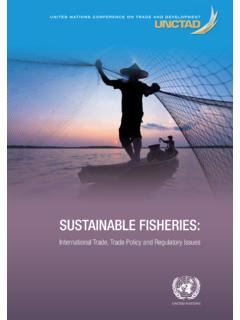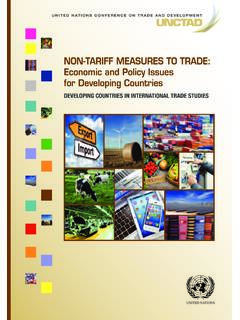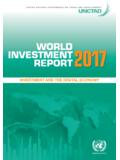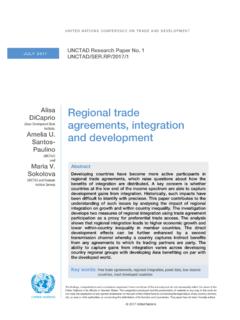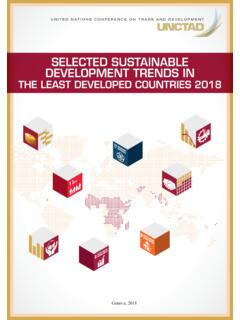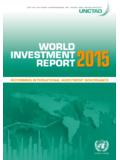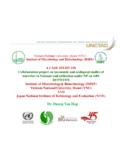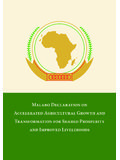Transcription of Saygili Trade Area - UNCTAD
1 F e b r u a r y 2 0 1 8 UNCTAD Research Paper No. 15 Mesut Saygili Ralf Peters Christian Knebel Division on International Trade in Goods and Services, and Commodities, UNCTAD African Continental Free Trade area : Challenges and Opportunities of Tariff Reductions Abstract African Union member States are in the process of establishing the Continental Free Trade area (CFTA) in order to boost Trade and economic growth and strengthen integration among African countries.
2 A main objective is to eliminate tariffs on intra-African Trade in goods. This study estimates costs and benefits of tariff reduction in four different scenarios. The results indicate significant welfare gains, output and employment expansion, and intra-African Trade growth in the long-run. Gains are not distributed equally among member States. In the short-run, countries are likely to bear some tariff revenue losses and adjustment costs which may not be distributed uniformly across the African continent.
3 Both, costs and benefits are reduced if sensitive products are exempt from liberalization. An unequal sharing of costs and benefits may hinder negotiation processes. Thus, sufficient flanking measures and flexibilities are needed to mitigate the costs of adjustment in member States. Key words: Tariffs, Welfare, Adjustment Costs, Continental Free Trade area (CFTA) 2 UNCTAD Research Paper No. 15 _____ _____ Contents Acknowledgements .. 2 Executive summary .. 3 1. Introduction.
4 5 2. Regional integration and adjustment costs .. 6 Benefits from regional integration in the long run .. 6 Short-run: Effects during transition .. 8 3. Simulating tariff reform: Long-run effects .. 11 Methodology .. 11 Welfare, GDP and employment growth .. 12 Exports, imports and Trade balance .. 13 Distribution of costs and benefits .. 14 Variation of the number of sensitive products .. 16 4. Tariff reform: Short-term adjustments effects .. 17 5. Conclusions and recommendations.
5 19 References .. 21 Annex .. 23 Acknowledgements This paper was prepared by Mesut Saygili , Ralf Peters and Christian Knebel ( UNCTAD ) with inputs, guidance and supervision from Bonapas Onguglo, Head, Trade Analysis Branch, Division on International Trade in Goods and Services, and Commodities, UNCTAD , Geneva. 3 UNCTAD Research Paper No. 15 _____ _____ Executive Summary In 2012, the fifty-four member States of the African Union agreed to establish the Continental Free Trade area (CFTA) by 2017.
6 The CFTA is widely seen as a crucial driver for economic growth, industrialization and sustainable development in Africa. Despite the opportunities, challenges need to be addressed. Fears of significant tariff revenue losses and an uneven distribution of costs and benefits are among the main obstacles to the continent's integration. Flanking measures and flexibilities should be explored for a fair sharing of costs and benefits, to reduce adjustment costs and to attain the full long-term benefits of the CFTA.
7 In the long-run, Trade liberalization in the CFTA lowers Trade costs and allows consumers to access a greater variety of products at lower prices. Lower costs for imported raw materials and intermediate inputs increases competitiveness of downstream producers and promotes the generation of regional value chains. Trade liberalization also allows firms to access a large continental market and gain from economies of scale. In the long run, increased competitive pressures may improve firm efficiency. However, market consolidation may arise when smaller firms are exposed to stiffer competition.
8 While most of the potential benefits of Trade liberalization accrue in the long run, short-run structural change through the relocation of labour, capital and other factors of production entails costs of adjustment. Short run and long run effects of Trade agreements should therefore be distinguished. Crucial private adjustment costs arise from temporary unemployment and lower wages in declining sectors, and similarly from underutilized capital. Costs of upgrading labour skills or training for new skills are also part of private adjustment costs.
9 For the public sector, lower tariff revenues are the most pronounced concern in many developing countries. Still, a rise in costs of social safety nets and implementation costs of Trade reforms remain significant public costs of adjustment. Most empirical studies in the existing literature on Trade liberalization tend to find that long-run gains outweigh short-run adjustment costs. The study first considers two different long-term scenarios for the CFTA. In a second step, it looks at the implications of different tariff reduction modalities on short-term adjustment costs.
10 We use the Global Trade Analysis Project (GTAP) computable general equilibrium (CGE) model to assess the long-run outcomes of the CFTA under different scenarios. Scenario 1 (full FTA) assumes that all tariffs will be fully eliminated in the CFTA. Our long-term simulations find substantial welfare gains of about US$ billion, even after deducting US$ billion of tariff revenue losses. The tariff revenue loss is equivalent to per cent of current revenues. GDP is expected to grow by per cent and total employment rises by per cent.
